Brooklyn’s Church Avenue runs from 37th Street between 13th and 14th Avenues on the Borough Park-Kensington border east and northeast to East 98th Street near Brookdale Hospital in Brownsville. The B35 bus runs the avenue’s entire length, and when my mother or father didn’t mind transferring buses (from the B16 on Ft. Hamilton Parkway), when I was a kid we would often ride it out to Flatbush Avenue, at least, which then as now was a prime shopping mecca. (There was a world-class candy store at Flatbush and Caton Avenues.) Oddly we did not go to the huge Sears at Bedford Avenue and Beverley Road, though we knew people who did. Very occasionally one parent or the other would ride the entire line with me out to Brownsville, but that was developing into a tough area even in the mid-60s. Just about every Saturday or Sunday, weather permitting, I loved to take a bus ride on the various routes near our house — the B16, B63 (5th Avenue), B37 (3rd Avenue), B4 (Bay Ridge Parkway), B64 (86th Street and Bath Avenue to Coney Island). What was I doing? Checking out the various street sign stylings, lamppost varieties, anything having to do with infrastructure — laying down the foundation for this web page.
Church Avenue was previously known as Church Lane and East Broadway east of Flatbush Avenue. As we’ll see it is named for the First Dutch Reformed Church at Flatbush Avenue, a congregation that has existed since the 1650s and a building in existence since 1799. The road itself is a very old road going back to the first European presence in Long Island. Originally it was a conveyance for cattle and hay wagons to and from the salt marshes that originally constituted a great deal of East Flatbush. Salt hay was an important cattle feed. Later, as the Reformed Church gained in importance the road was named for the church. Today’s Church Avenue follows closely its original path until about Utica Avenue; after that it turned northeast dramatically into the town of New Lots.
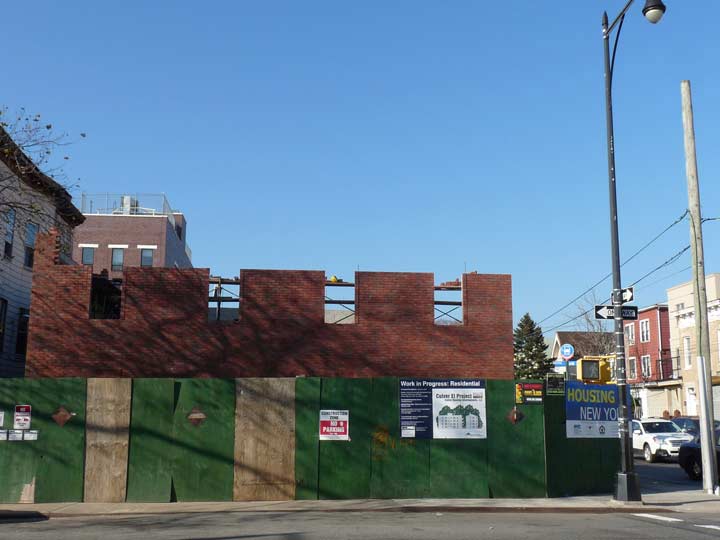
I began my Church Avenue walk with a few stops in Borough Park, which I’ll expound upon in a future page. To reach the west end of the avenue, I turned the corner at 13th avenue and 37th Street, where a housing project named for the old Culver Elevated is going up.
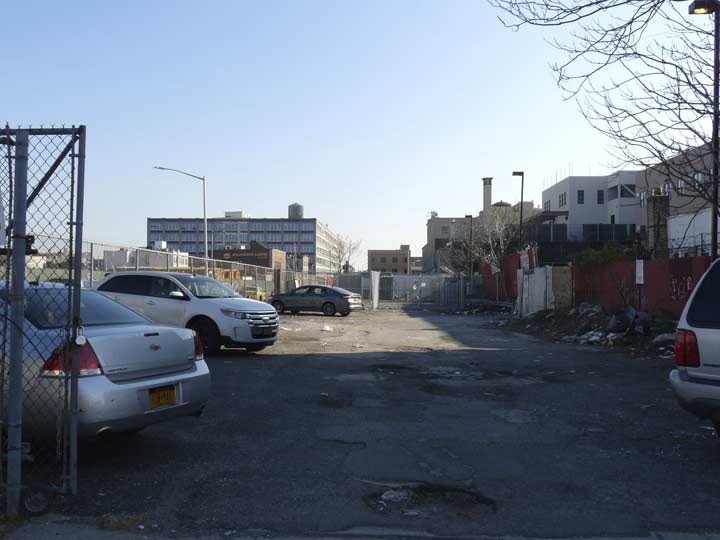
This particular spot not only used to be beneath the Culver El, it was also on the right-of-way of the freight-only South Brooklyn Railroad, which was used to get Transit Authority supplies and equipment from the waterfront docks to the Coney Island Yards. The trackway ultimately ran down the center of McDonald Avenue. After 1980 a track connection from the Cross Harbor Railroad to the (present-day) D train tracks south of 4th Avenue took over the at-grade route. I look at Brooklyn’s waterfront railroads on this FNY page.
My primary memory of this space, however, isn’t railroad-related. The SBR ran infrequently, maybe once or twice a day, and the tracks were mostly unused. Therefore the local Italian guys took over the space and played bocce, a variety of lawn bowling. The old man and I would occasionally take in a game or two in this spot. Today many area parks have bocce courts.
An inauspicious beginning indeed for one of Brooklyn’s historic roads and main shopping streets. Church Avenue, identified by one bent street sign, begins as a sidewalk-free space between buildings on 37th Street. In case you are scoring at home, Church Avenue is the only street in Brooklyn that intersects both 37th Street and East 37th Street, and 36th would duplicate the feat if East 36th Street wasn’t replaced by Brooklyn Avenue.
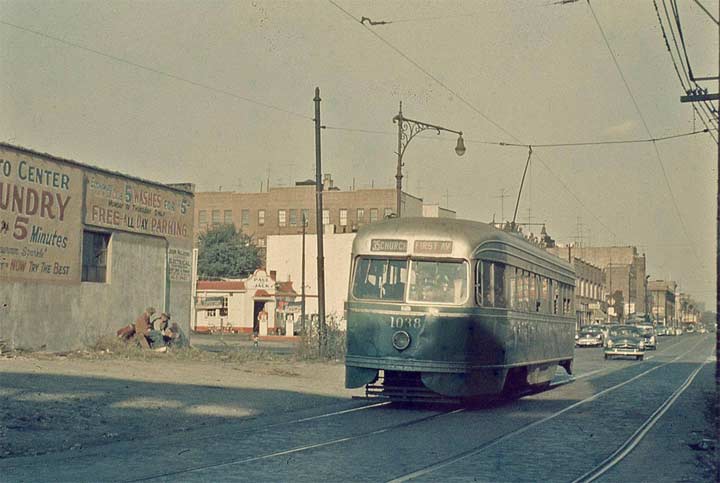
Here’s a mid-century view of the #35 trolley playing a route between 36th and 37th Streets en route to Church Avenue just up ahead. It’s really a right of way space between buildings without sidewalks, but today is marked as a prt of Church Avenue. More on the trolley below. Photo courtesy Al Ponte’s Time Machine (facebook)
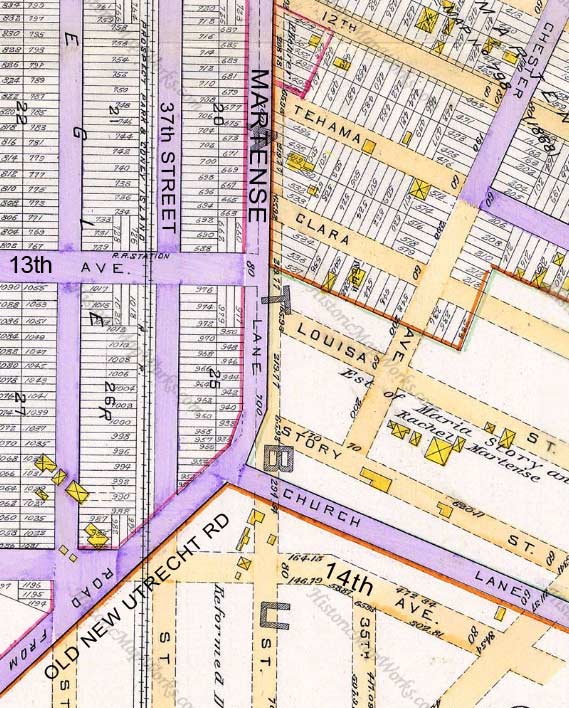
This 1890 plate from a Kings County map shows the original west end of Church Avenue. It was a fork in the road from Martense Lane (today’s 36th Street) and Old New Utrecht Road, two pieces of which still exist. On this map, property and lot lines are indicated, but the only existing roads were shown in purple; the rest were still on the planning boards. Note that 14th Avenue paralleled Church Avenue; today, it intersects Church Avenue at 35th Street. Story Street was lengthier then, and now runs north-south.
The Clara, Tehama, Louisa and Minna street names are supposed to have been the daughters of a local developer, but he has never been identified. In this context Story is a Dutch family name, and the street is named for the family’s local holdings. See the notation “Est. of Maria Story.”
A short piece of the unusually named Old New Utrecht Road intersects Church Avenue and 36th Street; it was unmarked by the Department of Transportation in December 2015, though I imagine it will soon gain new signs in the Clearview font. The only street in NYC beginning with “Old New,” it is an ancient colonial-era road in its own right. I gave it its own profile in an early FNY page.
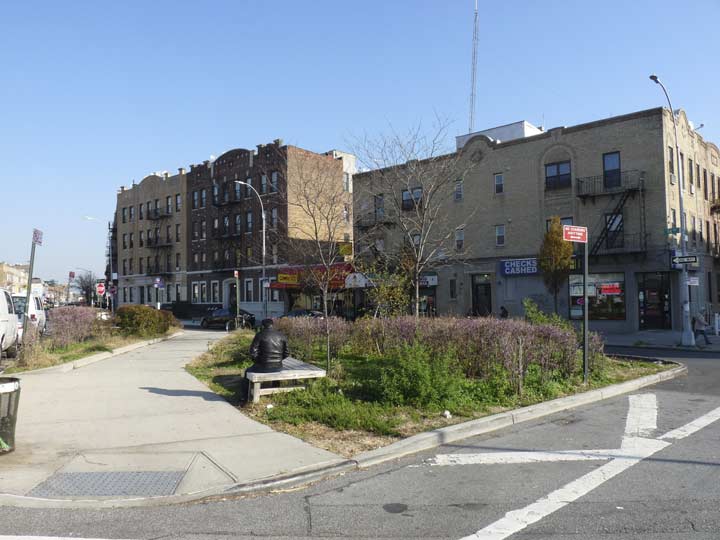
Here 14th Avenue intersects Church Avenue as the street grid of Gowanus, Park Slope, Sunset Park, Bay Ridge and Bensonhurst runs into the street grid of Kensington, Flatbush, Coney Island, Gravesend, Sheepshead Bay and Canarsie. The former features numbered streets and avenues with no “East” Or “West” prefixes as a rule, while the latter has those, plus lettered avenues running east and west. In the early 20th Century some of the lettered avenues were given British-sounding names to add an air of sophistication.
Kensington Dental Care, corner of Church Ave and Story Street, has marvelously hand-lettered front and side signs. The neighborhood of Kensington is named for a western borough of London; there are many British-sounding place names in the area, mostly by design since in the mid-1800s, when the region was developed, a patina of sophistication was desired. There were scattered farms around until the 1850s when the Coney Island Plank Road (Coney Island Avenue) was built and some dwellings began to concentrate at Coney Island and Church Avenues, as well as the northern end of the area near Ft. Hamilton Parkway. As early as 1851, the street pattern began to appear.
Kensington’s borders are generally accepted to be Ft. Hamilton Parkway on the north, 18th Avenue on the south, 36th Street and Dahill Road on the west and Coney Island Avenue on the east, though some demographers fudge a little, saying separate areas called Dahill (defined by a triangle formed from FHP, Dahill Road and 36th Street) and Albemarle (the northern extent from FHP south to Church Avenue) are subsections.
While Story Street runs for just one block, its offshoot, Story Court, is one of the shortest streets in Brooklyn. But that’s not the most unusual thing about it.
The intersection of Story Court and Street is marked by a pair of 1964-vintage black and (faded) white vinyl street signs that the Department of Transportation has forgot. I fully expect these two to vanish in the next round of Clearview-font replacement street sign purges. Maybe not, though. Note that Story Court is marked “private property” and thus, the court may be outside the DOT’s power to replace the signs. The next year or two will tell the er, ah, story.
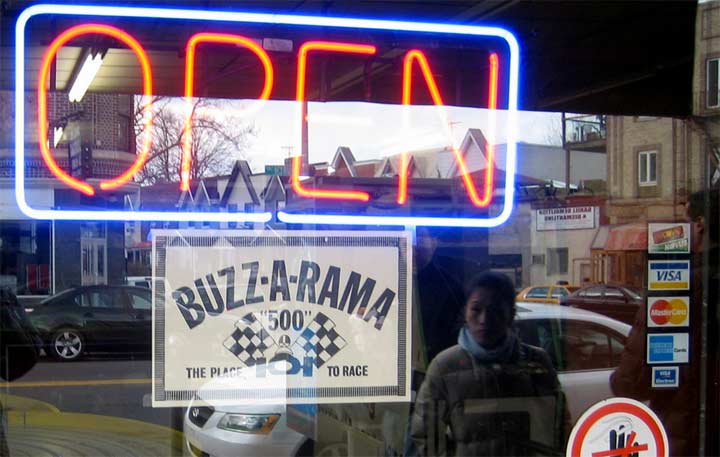
Returning to Church Avenue, a lengthy storefront at Dahill Road is unmarked for the most part, except when it’s open on weekends. Then it’s known to Kensington kids, and enthusiasts around the world, as Buzz-a-Rama, the world capital of slot car racing. The mecca has been operated by Frank “Buzz” Perri, now nearing 80, since 1965. For those unaware, slot cars are guided by miniature 12 volt D.C. motors set in the underside of model cars along a central groove in the track in which they run. Racing buffs, young and old, bring in their own cars, or rent them here, and rent space by the hour.
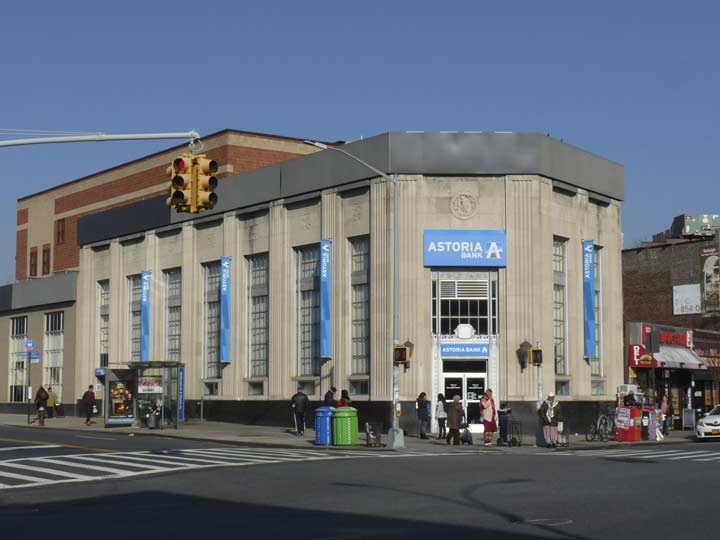
Astoria Bank, formerly Astoria Federal Bank, at Church and McDonald Avenues.
Astoria Federal Savings was chartered as Central Permanent Building & Loan Association in 1888, and became Astoria Federal in 1936, which seems about right for the date this branch at McDonald and Church Avenues was built. This branch was formerly the Greater NY Savings Bank, purchased by Astoria in 1996.
It’s streamlined, as buildings started to be in that era, but architects were still able to add touches like the beaver, a symbol of thrift as well as of New York State (let’s not forget the bank’s namesake, John Jacob Astor, the USA’s first millionaire, made a smash as a fur trader and initially, as a dealer of musical instruments.)
In late 2015, word came that Astoria Bank will merge with New York Community Bank, and drop the Astoria name.
McDonald Avenue was laid out as Gravesend Avenue in the mid-19th Century (it plunges south toward that neighborhood) but was renamed in the 1930s for John McDonald, a chief clerk in the Kings County Surrogates Court, who had choked on a chicken bone. If such an unfortunate occurrence happened today, McDonald would probably get his name on several signs along the street’s route, but the Gravesend name would probably be retained.
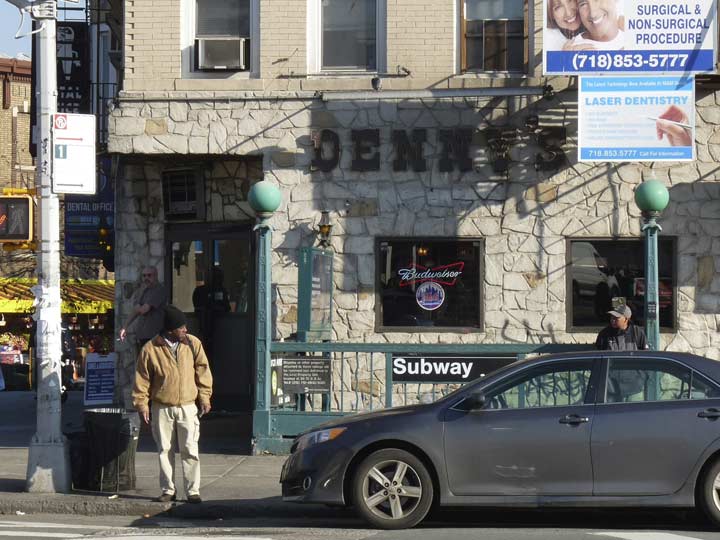
There are three Church Avenue subway stations, one each for the old IND, BMT and IRT designations. This is the only one that is a terminal as it is the southern end of the G train, a line that has had both its terminals changed seemingly serendipitously over the years. Formerly the GG local, it used to run between the Smith-9th Street station and 71st/Continental in Forest Hills, Queens. Most of its Queens trackage was reduced to tow stops as other local trains took its place on the Queens Boulevard line. The Smith-9th terminal was convenient only for train dispatchers, so the MTA deigned to extend the service south to Church Avenue, and it can now free-transfer to the R at 4th Avenue. Rarely, when there is trackwork on the F, the G is extended south to Coney Island, where a transfer exists to the D, Q and N.

1890 map of Church Avenue east of McDonald Avenue. Essentially the street layout is the same today, though Avenue B has become Beverley Road and has gained a Church Avenue intersection.
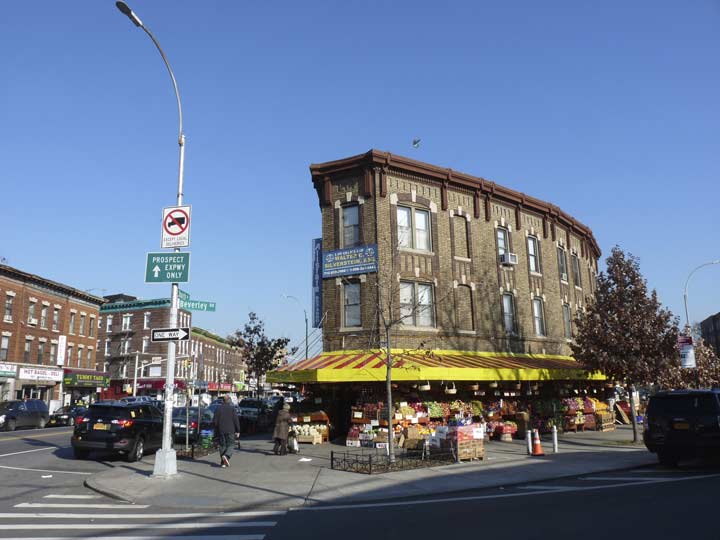
The curving Beverley Road intersection with Church creates a strangely-shaped plot and a building with an oval shape.
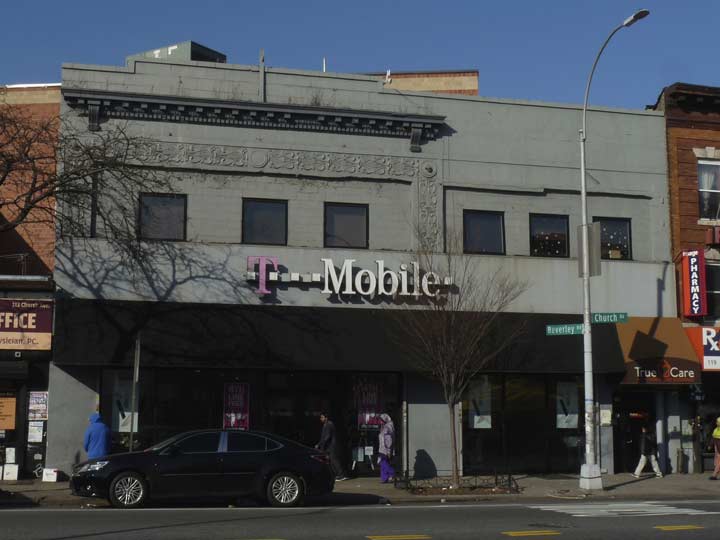
This is what remains of the Beverl(e)y Theatre at Beverley and Church. The theater opened for business in 1920 and closed in 1981. It’s the first of two defunct theaters along Church Avenue, the other being the Kenmore near Flatbush Avenue. There’s a great picture of the Beverl(e)y at cinematreasures in its 1970s grindhouse glory days (also note the Muhammad Ali-Ben Foster bout on closed circuit TV) next door to an Ebinger’s bakery.
Meanwhile, on the same block, I seem to remember an Italian restaurant, Scarola’s, where I attended a bachelor party in the 1980s.
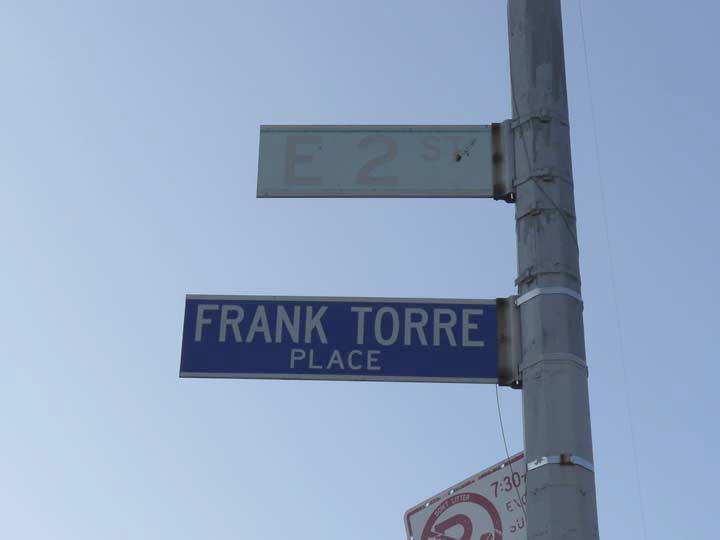
Frank Torre Place, Church Avenue and East 2nd Street was named for a local realtor and civic leader (1923-1991) in 1993 and not, to my surprise, the former major leaguer and brother of NL All-Star and great NY Yankees manager Joe Torre. The street between Church and Beverley received the designation in 1993, when the city was still installing blue and white street signs for honorary subnamings.
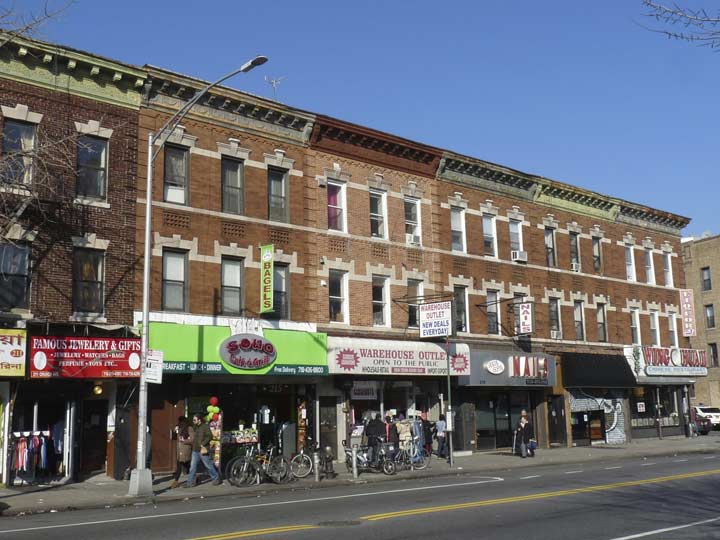
Church Avenue storefronts/residences. These likely went up in the Teens or Twenties. The original roof treatments are intact, painted a different color for each building.
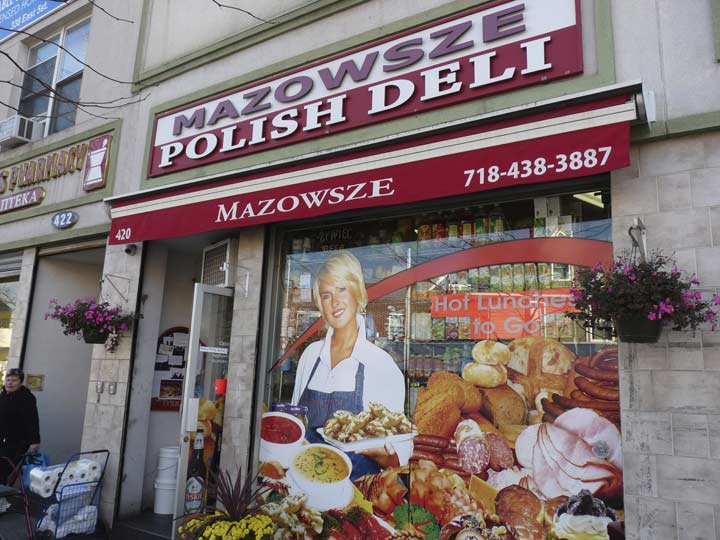
I was unaware of a Polish presence in Kensington, but it’s here, at least.
The handsome synagogue at East 5th and Church is officially known as the Flatbush Jewish Center, though Flatbush pretty much centers around its namesake avenue, about 20 blocks east. Kensington can be considered part of “Greater Flatbush” along with neighborhoods like Midwood, Parkville and East Flatbush.
The Conservative congregation was organized in 1921 as the Jewish Center and Congregation of Kensington. When the present building was completed in 1924, the name was changed to the Jewish Center of West Flatbush. In 1926, the name was again changed to the Flatbush Jewish Center. In the 1960s, it merged with Ahavath Achim and Shaare Torah to become the Flatbush and Shaare Torah Jewish Center.–Matthew X. Kiernan
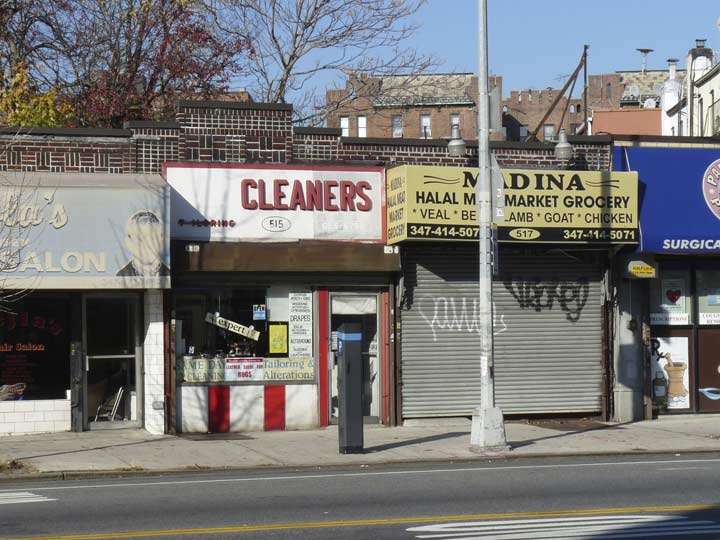
Classic wood-lettered “Cleaners” sign on Church, east of East 5th.
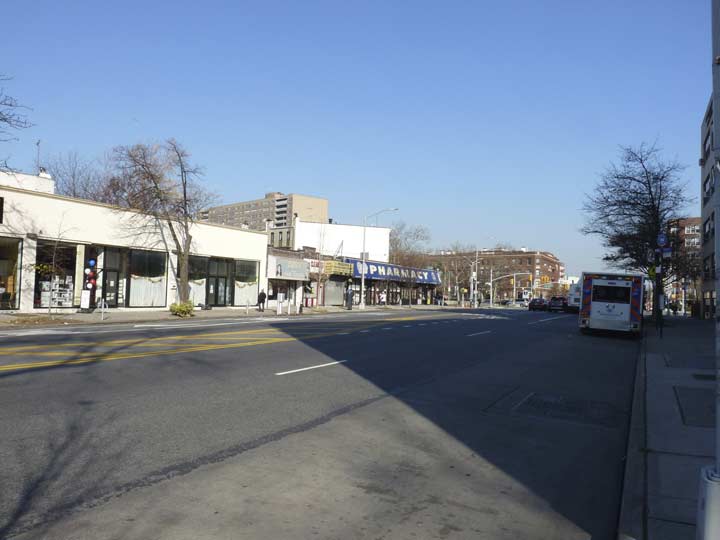
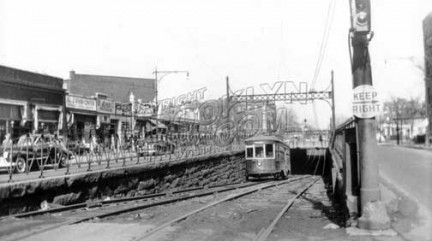 Church Avenue fattens up into a multi-lane behemoth on the two blocks either side of Ocean Parkway. Was this a short-lived attempt by the city to turn it into an expressway, as the Prospect Expressway was extended north from Church avenue to the BQE? No. This was the former route of streetcar line #8 (later #35), which ran from a former ferry at the end of 39th Street in Sunset Park along Church Avenue to Hegeman Avenue in Brownsville. photo: brooklynpix.com
Church Avenue fattens up into a multi-lane behemoth on the two blocks either side of Ocean Parkway. Was this a short-lived attempt by the city to turn it into an expressway, as the Prospect Expressway was extended north from Church avenue to the BQE? No. This was the former route of streetcar line #8 (later #35), which ran from a former ferry at the end of 39th Street in Sunset Park along Church Avenue to Hegeman Avenue in Brownsville. photo: brooklynpix.com
To avoid crossing Ocean Parkway Church Avenue’s trolley tracks were placed in a tunnel. After the streetcar was discontinued on Halloween 1956 (one of the last trolleys to run in Brooklyn) the tunnel was filled and to my knowledge, no trace remains.
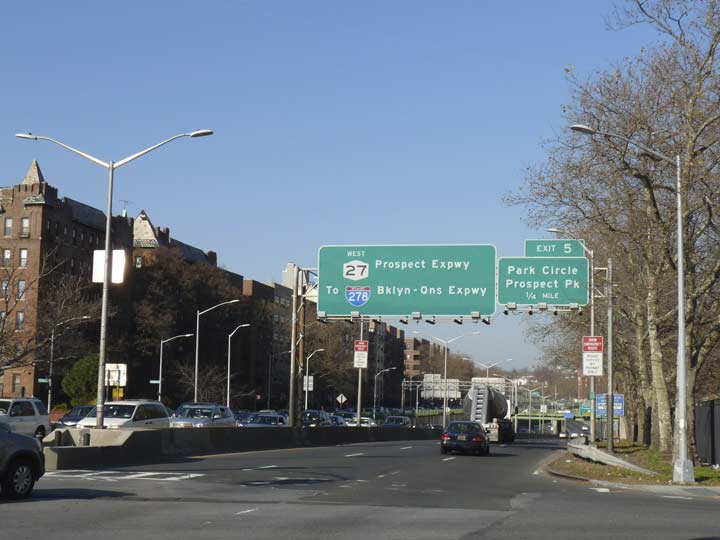
Ocean Parkway is the oldest major north-south route in southern Brooklyn. It was constructed between 1874-1880 as a broad wagon and carriage route by its chief engineers, Calvert Vaux and Frederick Law Olmsted, the architects of Prospect and Central Parks. It retains its bike and bridal paths and is one of Brooklyn’s fastest auto routes with synchronized stoplights on the at-grade surface.
North of Church Avenue, Ocean Parkway becomes the Prospect Expressway, bruited through Kensington, Windsor Terrace and Park Slope by traffic czar Robert Moses to link Ocean Parkway and the Brooklyn-Queens Expressway between 1953-1960. Moses, I have read, desired to turn Ocean Parkway into either an open-cut or elevated expressway, but was rebuffed, though I’ll have to check my Robert Caro about this. Ocean Parkway was given a Landmarks designation in 1975, so it cannot be altered that way in the future.
State Route 27 eventually reaches Montauk Point in Long Island, but in Kensington and Flatbush, it travels along Caton Avenue and Linden Boulevard and several directional signs appear in the neighborhood. At this juncture it’s doubtful if any motorists pursue a strict path on Rte. 27, but I imagine the state is legally bound to mark the route.
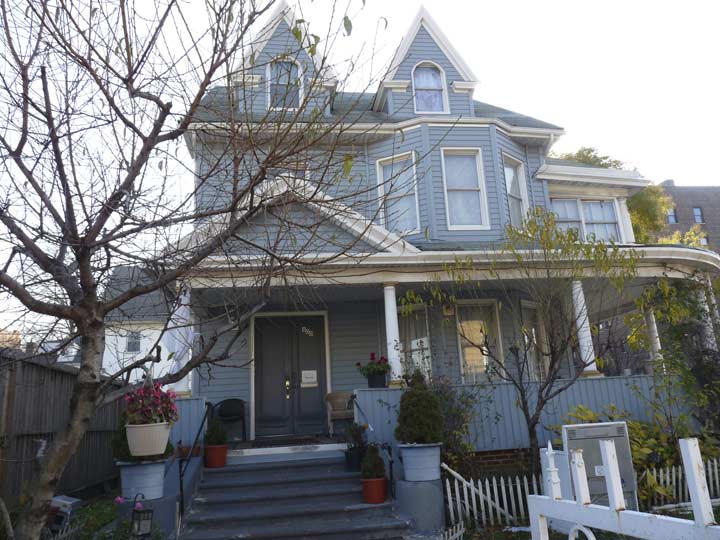
Although Church Avenue remains a shopping and business strip, it is on the northern end of a residential section, and east of East 8th Street, it’s actually in a landmarked district. However, #200 at West 8th is an outlier. Its closest neighbor is a car wash.
Coney Island Avenue is also a very old north-south route and appears as the “Coney Island Plank Road” on late 19th Century maps. Photos from that period show it, and its steam railroad tracks, seemingly receding into infinity in an otherwise empty landscape. The steam railroad became a streetcar line and ultimately, the B68 bus.
At the corner of Coney Island and Church Avenues and running east to East 10th Street we see three different philosophies in store signage. Andrew’s Coffee Shop (not to be confused with the former Manhattan coffee shop franchise) is quite “busy”: plenty of text, address, phone number, partial menu, etc.
Then we have the motorcycle shop next door. You have to squint to see the name of the store, prospectcycles.com, on the door. The name of the store in this context isn’t important; the Yamaha and Kawasaki bikes inside are.
Next to that is a blank sign with just one word: “WHEATED.” Since I’m unfamiliar with the place, I’ll guess that it’s a breakfast and lunch place serving bagels, cereal, etc., that kind of thing.
OK, after looking at the online menu, I find it’s a pizza place. It displays none of the iconography usually associated with pizza places, which usually are brightly lit with signage in red, green and white, the colors of the Italian flag. Thus: I’ll infer Wheated is looking for pizza aficionados — but not the sort of pizza aficionados who go to the dollar slice stores. A blank, or nearly blank, sign indicates that they are looking to build up a clientele who has heard about them elsewhere, but they are not going to resort to ‘loud’ signage to bring in walk-in customers. The fare is not conventional pepperoni, anchovies, etc. but somewhat more creative (think octopi), and it serves liquor instead of fountain Diet Coke. Online reviews are good.
Proceeding east from Coney Island Avenue just south of Church Avenue is Albemarle Road, part of a development known as Prospect Park South.
Prospect Park South was developed at the turn of the 19th-20th Century by upstate New Yorker Dean Alvord, who purchased a parcel of land in Flatbush from the estate of Luther Voorhies and the Dutch Reformed Church in 1898. Alvord, with the aid of architect John Petit, set about building sumptuously-appointed buildings for the well-to-do. By 1898 Flatbush had evolved from farmland into a well-established community that boasted good schools, decent local trolley lines, and the Brooklyn Rapid Transit Company, the precursor of the BMT (Brooklyn-Manhattan Transit) offered easy transport to Manhattan via the Brooklyn Bridge on what was once a steam line called the Brooklyn, Flatbush and Brighton Beach Railroad that evolved into today’s B/Q train.
Alvord’s idea was to extend Prospect Park South and adapt it to residential use. He foresightedly buried utility lines underground (other Brooklyn neighborhoods are marred by overhead utility wires) and paved the streets in an age when many were still dirt roads or Belgian-bricked. Streets were given British-sounding names. Grand houses of every description appeared: neo-Tudors, French Revival, Queen Annes, Italian villas, Colonial Revivals, Mission styles, and houses designed to individualistic styles and bearing no relation to previous forms. Undoubtedly, many of the houses bear a resemblance to the grand southern plantation mansions.
Neighborhoods south of Prospect Park South such as Ditmas Park, Beverley Square, and Fiske Terrace sprung up shortly after Prospect Park South’s development, and adhered closely to Alvord’s vision. Prospect Park South homes have featured in movies of recent decades such as Sophie’s Choice and Reversal of Fortune. In the early 20th Century, the Vitagraph Studios in Midwood was the epicenter of filmmaking in the USA and many film stars made their homes in Prospect Park South and the neighborhoods to the immediate south.
In 1977 Prospect Park South was designated a NYC Landmarked District.
“Corvington” lamps with the same design as the ones that first appeared in the 1910s have been installed along this section of Church Avenue. The NYS 27 sign directs traffic to turn left here at Stratford Road to pick up the state road at Caton Avenue. When Dean Alvord laid out Prospect Park South and commissioned brick pillars bearing the street names, he likely didn’t envision state roads for combustible engine traffic.
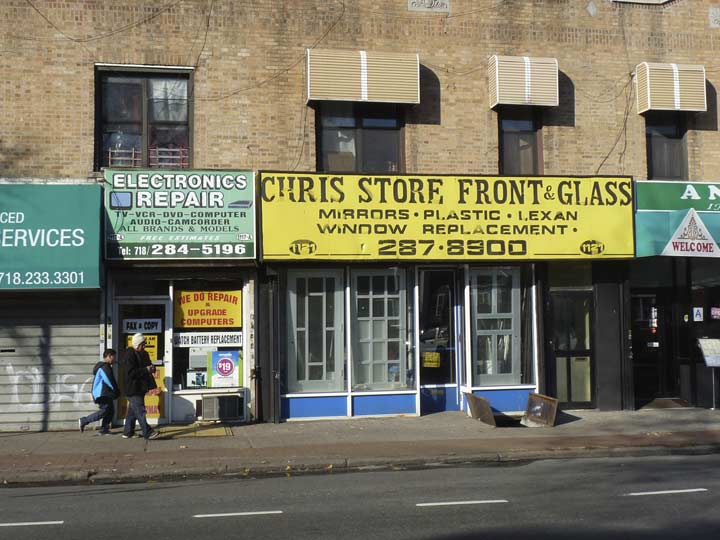
I continue to have a keen eye for store signs like this hand-lettered number between Stratford and Westminster.
A sampler of some of the beautiful homes visible on the side streets of Prospect Park South. These ate within a short walk from Church Avenue or even border on it.
The Temple Beth Emeth (House of Truth) at Church Ave and Marlborough Road was designed and opened in 1913; the congregation was established two years earlier. Its construction marked the beginning of Jewish religious activities in the Flatbush area, and today parts of Flatbush remain heavily Jewish.
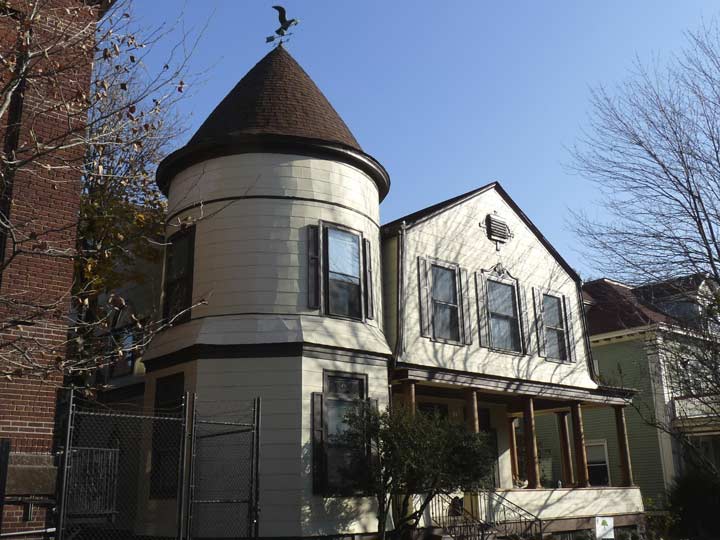
#91 Marlborough Road, adjacent to the synagogue, was built in 1901 and features a corner tower and small shutters that are strictly ornamental.
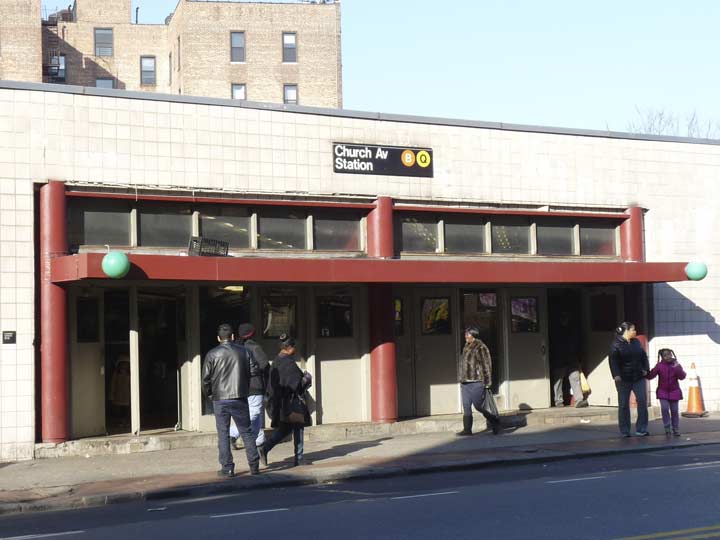
The Church Avenue station for the B and Q subway lines is the second one the avenue encounters traveling east. It’s a BMT express station serving the B (express) and Q (local) and can trace its existence back to the surface steam railroad Brooklyn, Flatbush and Coney Island Railway, which first ran in 1878.
What became the Brighton Line had its beginnings in 1877 when it was planned as just one of a group of steam railroads that connected downtown Brooklyn, or its outskirts, with the hotels and resorts at Coney Island and Manhattan and Brighton Beaches. At the time, most of Kings County was a rural enclave with farms and small towns connected by roads like the Old Flatbush Turnpike, later straightened and renamed Flatbush Avenue, and Kings Highway, which followed an old native American path through the woods.
In 1877, the Brooklyn, Flatbush and Coney Island Railway was incorporated, opening the next year in 1878. It originally ran from the Prospect Park entrance at Flatbush and Ocean Avenues south to the Brighton Beach Hotel, built near the water’s edge. Until 1899, steam locomotives were the rule on both the elevated and surface railroads. In 1899 elevated trains began running on the Brighton Line, in addition to steam service, but all steam was done away with by 1903.
Beginning in 1905, the Brighton Beach was brought to its present-day arrangement by eliminating all grade crossings. The northern part (now the Franklin Shuttle) would be on an elevated structure; south of about Prospect Place, trains would run in an open cut; and south of Foster Avenue, trains would run on an embankment created from land excavated to submerge the Bay Ridge Branch of the LIRR in its own open cut. Many cross streets would be depressed to travel under the embankment, but some, such as Avenues I and X, would stop at the embankment, vexing travelers to this day. Brighton Beach BRT service continued along the parallel LIRR Manhattan Beach branch (later closed in 1924) while the grade crossing elimination project was underway.
In 1913, the NYC Board of Estimate and the NY State public service commission approved a plan for subway expansion known as the Dual Subway Contracts. The Dual Contracts, named for its BRT and IRT components, expanded the NYC subway both by building new lines and incorporating older surface railroads and upgrading them by submerging them into tunnels or running them on new elevated structures. As part of the Dual Contracts, a tunnel was constructed beneath Flatbush Avenue — joining the IRT tunnels already there — to join the Brighton to lines crossing the new Manhattan Bridge.
This Church Avenue station first opened in August 1907 and no doubt looked a lot different than its present, 1980s-vintage bland exterior. In the present configuration the B runs only weekdays and joins several other lines in Manhattan and the Bronx, never having any part of track to itself. The Q travels up the Broadway and Astoria lines.
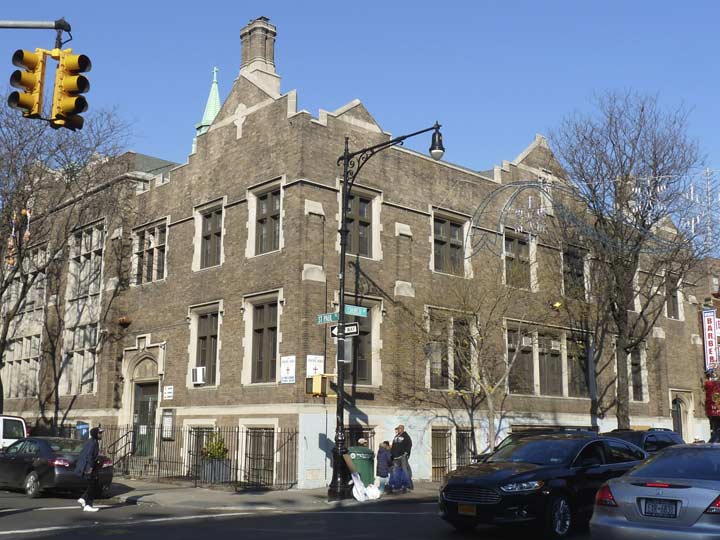
At Church Avenue and St. Paul’s Place is the school associated with the venerable Anglican/Episcopalian parish, first established in 1836. The now-venerable church building was built in 1877 a block north, and it’s worth a look. Of course St. Paul’s Place and Court were named for it.
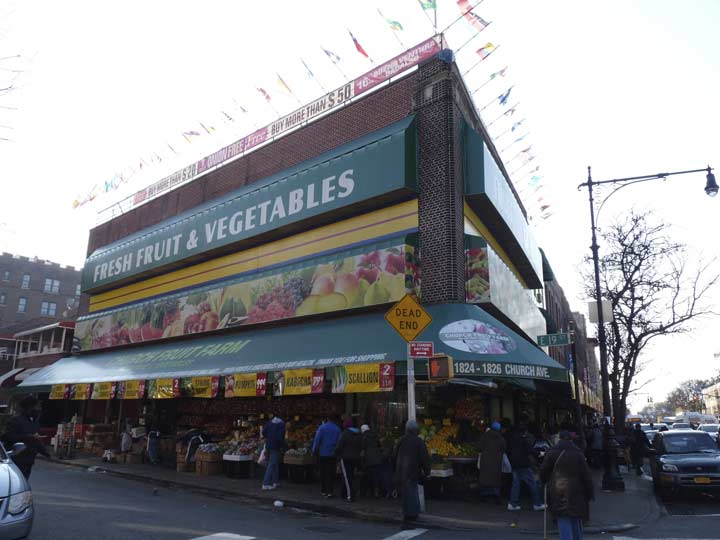
After skirting the northern edge of Prospect Park South, Church Avenue has entered its busiest shopping district as it approaches Flatbush Avenue. Square foot for square foot this could be the borough’s biggest retail district. East 19th ends at the Brighton Line open cut.
The former Kenmore Theater takes up half the entire north frontage on Church Avenue between East 22nd Street and Flatbush Avenue. The theater, which had a distinctive black marquee with white letters (like the Albee on DeKalb Avenue downtown) opened in September, 1928 and closed in 1999 with “The Matrix” on the bill. Cinematreaures has a photo of the Kenmore in its heyday. In the last decades of its existence the Kenmore was not exactly safe, due to gang activity and crime.
East 21st Street was formerly called Kenmore Place (a short landmarked residential area issuing from it is Kenmore Terrace, seen on this FNY page).
Beverley Road is a block south and the owners of the large bridal emporium at Church Avenue and East 21st have cleverly named it for Beverly Hills, California.
Next week: the church of Church Avenue
1/10/16

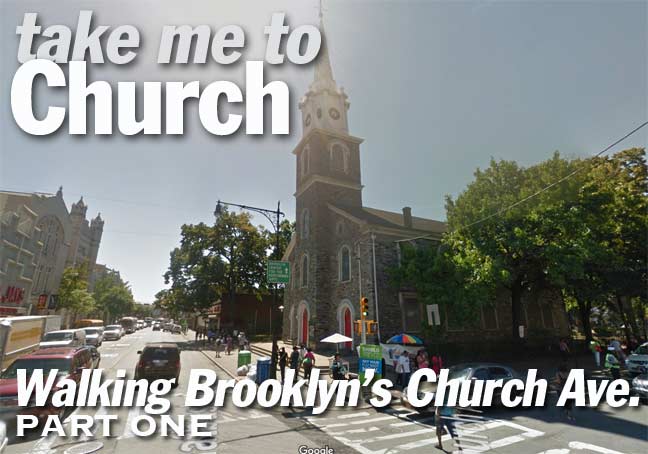
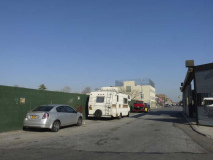
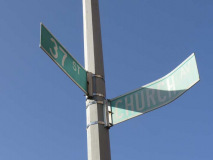
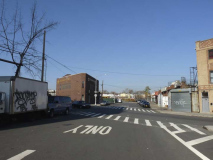
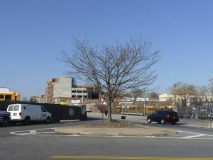
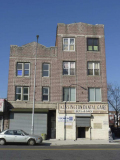
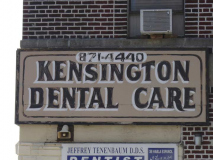
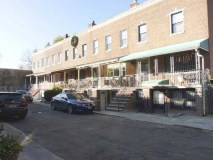
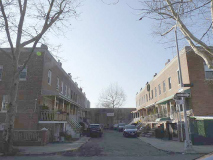
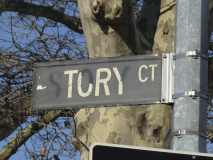
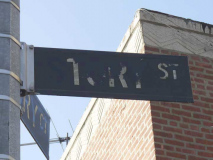
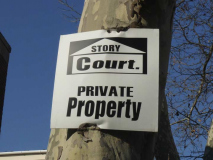
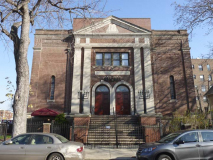
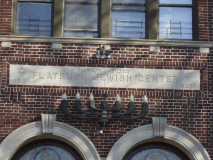

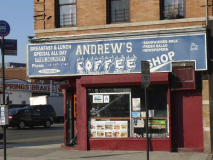
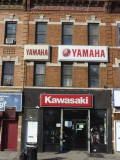
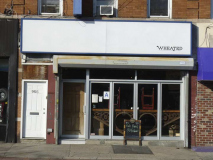
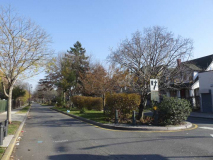
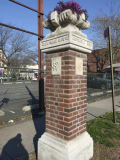
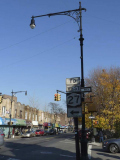
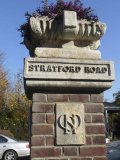
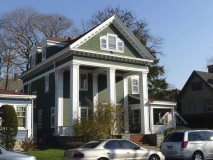
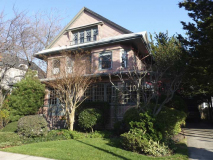

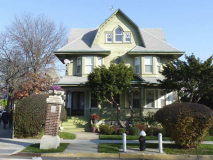
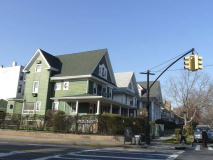
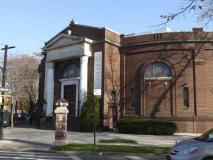
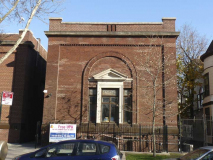
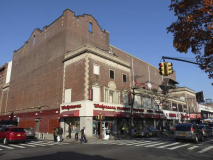
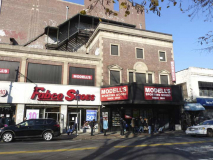
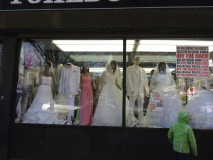
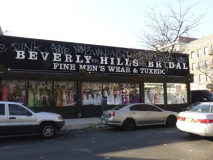
65 comments
Kevin, thanks for this insightful look at my neighborhood (and beyond).
I trust your future report will look at the enormous kosher ice cream parlor just at the beginning of Church. See:
http://www.yelp.com/biz/the-ice-cream-house-brooklyn-4
I passed it — but I was there on Saturday and the shutters were down
The Church Ave tour brought back old memories. In the early 60’s I used to deliver The World Telegram & Sun throughout Borough Park. All the streets and avenues were numbered, so it was nearly impossible to get lost, and you could gauge how long it would take to complete a route. One afternoon, the manager asked me to come back to the office (52nd St and 18th Ave) after my regular route and deliver for someone who was sick. When I got back, he gave me the list of subscribers on Clara, Tehama, Minna, etc. I had NO idea where these streets were!. He said “Just head up Old New Utrecht Road to 17th Ave, then up to Dahill Rd, and you’ll see them when you cross Church Ave.”. We had a short section of Dahill Rd. near where I lived on 51st St, so I figured it couldn’t take too long.
Well, I found the neighborhood, delivered the newspapers, and made it back home long after dark. My folks wondered whether I’d been run over. Even they had never heard of those obscure little streets in the far corner of Borough Park!
Clara, Minna and the other streets are actually in Kensington.
Not Dahill? Just joking! Technically, I grew up in Parkville (51st and 19th), but I never heard that neighborhood appellation used until I found FNY. It’s amazing how many “new” neighborhoods have been “discovered” in the last 50 years. Kevin, keep up the great work!
A recent factoid I came across courtesy of the “MTA Subway Museum” annex at Grand Central Terminal is that Ocean Parkway (along with Great Eastern Parkway) is (are) the widest street(s) in New York City.
FYI….The trolley tunnel under Ocean Pkwy was closed and the tracks pulled up and donated to the Trolley Musuem in Conn…..all the trolley tracks at the loop(37th Street Ferry at 37th St & 2dAv)were also donated to the Musuem…….I rode that trolley in 1953 & 1954 as we had family in Brownsville and we lived in Brighton Beach(CI Av to Church then Church to Brownsville)….I sure do miss those old PCC’s…
“Seinfeld” gave us the Soup Nazi & we laughed. Apparently, the joke was on us because 20 or so years later there’s Wheated. Would it kill them post a sign with bolder graphics & a pizza subheading? Are they ashamed of themselves or are they ashamed of the clientele a pizza restaurant might attract? Urban revival is great, but hipsters…not so much.
Geez, you are making a lot of assumptions based on what? Our signage? Please come in and say hello one night. Ask for David. I am the owner of Wheated.
Thanks, David. Before posting, however, I checked your web based menu. Your prices seem reasonable & I’m sure you run a fine restaurant. My criticism was mainly about your signage, which seems to break all the rules. However, I guess in today’s Brooklyn it’s what’s expected (& I still don’t get it). I won’t be able to accept your invitation because I relocated to AZ. 10 years ago & I have no intention of returning; don’t worry, there’s plenty of good pizza west of the Hudson – for instance:http://www.valentinoseateryaz.com/ . Celebrated my anniversary there recently. Seriously, good luck to you, but I still think better signage would lead to better business (just sayin’).
I live on albermile road and east 2nd street. Thanks for all the memories. I remember taking the trolley car to Erasmus high. The tunnel under ocean parkway was an everyday event. The stores were terrific.
Too funny! I have been to wheated and the pizza is decent enough but I wonder about the sign every single day when I pass by! It is so ugly and bizarre and confusing! It looks like they ordered the wrong size lettering. The white space is just glaring and aesthetically unpleasing. That is the single thing that keeps me from going in there. Those of us on this site are all sign aficionados so know what i mean! David good pizza and drinks but what were you thinking with that sign!
Believe it or not, I have a strong art, design and marketing background (school and 20 year career). Commenting about the white space and aesthetics has me chuckling thinking back to what one of my professors would have said ohh so long ago as a critique. The usefulness, design/layout, hipness or lack of, etc can all be debated till blue in the face. The reality is our sign plays a very minor role in our business. We inherited it from the prior occupants and were stuck with it because of budget. With a couple of hundred dollars and my labor, I was able to remove the prior business logo and put our name up there. It would be nice to rebuild the front and replace the sign but that all depends on it becoming a priority and the money to do so being there. I am saddened that you and possibly others choose not to come in over our signage but I also learned long ago that I can not please everyone. It is all about priorities and assessing them as the business moves along. Anyway, I am rambling at this point. Thank you for coming in. I hope you can make it past the sign and come for another visit. Please say hello if you do. I try to be here much of the time.
David: I’ll come in next time in the neighborhood – the sign didn’t prevent my coming in but my schedule did.
I went to Wheated for the first time last week on the way to the beautifully refurbished Kings Theather to see the Beach Boys concert. The restaurant and the pizza were great! Congrats and good luck. I Grew up on Lenox road in 50’s-60’s and now live in New Rochelle but I will be back every time I revisit the Kings.
I like the sign and love the pizza. we go there all the time. ignore these old crackpots who dont even live in state anymore
Hipster-centric establishments have a habit of using what the proprietors consider “witty” or “quirky” signage which doesn’t allow the casual observer on the street to determine exactly what is the purpose of the business. In more than a few instances, the name or only an image used to identify the establishment has nothing to do with what’s going on inside. For all anyone might know, you could be selling vintage sweatsocks.
Ah, Scarola’s. Brings back fond memories. Both my grandmothers lived on the same floor of the same building on E 2nd between Greenwood Ave and Ft Hamilton Pkwy, so many birthdays and family events were celebrated at Scarola’s, including a few in the room in the back they used for catering. There also used to be Saul’s appetizing either on that block or the next one, renowned for it’s great lox, whitefish, etc. It always smelled great in there, although even as a kid I raised an eyebrow at the $3.19 price for a quarter pound of lox. Now it’s $8 and up.
The Story Street signs have almost been taken down a few times. When I see anyone from DOT working on the lamp post, I ask them to keep these historical street signs up. So far so good.
Thanks — keep a lookout!
Scarola’s restaurant was between Beverley and East 2nd streets, and they also ran a pizza place on Church between Rugby and Argyle. That’s where we went at lunchtime from PS 249. As I recall, their pizza was made with a very rich tomato sauce, different from all the other local pizza places.
I grew up on Kenmore Place in the 50’s and 60’s, but we always called it East 21st Street, and all of our mail, except for some junk mail, had an East 21st Street address, even though the corner street sign said Kenmore Place. We thought only our block between Caton and Woodruff Avenues had both names, but other parts of East 21st may also been called Kenmore Place as well.
Went to 249 mid 50’s early 60’s
Remember Scarola’s lunch special for students?
Double slice with small drink 25 cents. WOW!!!
Church Ave. trolley (by then #35) was the very last one (along with McDonald Ave.) to run in Brooklyn when it was bustituted October 31, 1956. The bus of course is still #35 and operates along the exact same route. McDonald trolley (#50) was not replaced with buses or anything else on the surface. It was decided that the Culver El with its then-new D train through service to downtown Brooklyn and Manhattan was a sufficient replacement.
Thank you for this wonderful article. It brought back lots of memories of growing up in the 40’s and 50’s on the “other” Albemarle Rd. between E2nd and E3rd.
Was your father the doctor ? I am just reading this in May 2020
Your article is wonderful.Thank you for it..I grew up in the area around Flatbush and Church Aves,,,,I rode the Church Ave Car many times as a youth…..I loved when the trolley Motorman would step on the gas and whisk us thru that tunnel under Ocean Parkway…
The “Dual Contracts” link should go to http://www.nycsubway.org/wiki/The_Dual_Contracts
The last trolley cars running in Brooklyn were the Church, Coney Island and McDonald Ave Cars..All were running with the PCC models that the BMT bought in the mid 1930’s…..
When I was five years old, living at 525 MacDonald Avenue, I loved the trolleys that passed by. When I heard that they would be replaced by buses, I felt miserable. My parents took me on the last run of the only “square fronted” PCC….. No. 1000. I hear it’s in the trolley museum in Connecticut now.
Love how the cinematreasures link (Beverly Theater) goes to a youtube video of DEVO performing “Whip It” on Merv Griffin!!!
yeah I’ll have to fix that
I worked at Sears on Beverly Rd in the late 60s, and the Greater NY Savings Bank on Church Avenue in the early 70s, so I got to spend time walking around or riding the bus at different parts of Church Avenue over the years. This posting brings back wonderful memories of the neighborhood, particularly the take out from Scarola’s during lunch/dinner breaks at the bank.
Funny story from my family’s past: In the late 1940s my mother lived on Linden Blvd. near Albany Ave. My dad lived on W. 111th St. in Manhattan. They met at a resort in Pennsylvania in 1946 and hit it off. Anyway, after a number of months of spending a great deal of time on the IRT followed by the Church Ave. trolley (which apparently had the same tendency as the later bus to run in bunches), Dad made up his mind to propose–either this relationship was going somewhere or he was wasting his weekends. The rest was history–at his death in 1992 they had been married 44 years. I was reminded of the story when the “Times” ran a story a few years ago called “When Love is a Schlep” about couples living in different boroughs.
This is a great post! I live in Kensington and spend a lot of time on Church, and several times a week I run to my gym at Church and Flatbush, the route you described here. It’s cool to learn some more about the streets and buildings I see everyday. It’s easy to take things for granted, not realizing how much history is everywhere around you.
wow, forgot what U responded to now…..we lived there in fifties and erasmus and all that jazz……..can get U in touch with others………………were is the gym….tkx.
So for you old timers who can go back to the 50’s and 60’s my father was the bagel baker on McDonald and Church – bagels never tasted better!
I loved that bagel store. I think bagels were 20 cents. Was your father the guy who smoked cigars?
How wonderful to see all these photos and memories of my Brooklyn. From 1946 until 1973 I lived on Ocean Parkway between Ditmas and Cortelyou. Graduated from Erasmus in 1964. Been here in San Francisco since 73.
On Facebook I head up the ‘Save the Erasmus Hall Academy’ effort, trying to re-claim and re-use the original 1787 building which is in a state of decay.
https://www.facebook.com/groups/810790769011024/
I lived at 80 marlbourgh road in the sixties corner of church ave what a area back then
.
i grew up down the block from you at 180 between albermale and beverly. called “doctors row” in the sixties. you were opposite beth emeth.
Anyone remember name of corner store at N/E corner of Church Ave and New York Ave in 50’s – 60’s. Had small soda fountain and news papers in front
Can’t member the name, but remember the place. Used to stop there all the time when I hung out at my grandparents’ apartment, after school, on Lenox Road, in the days before Kings County Hospital took over the area of Lenox for expansion. Also, there was a soda fountain across the street–don’t remember the name either, but had homemade candies and ice cream and was a little fancier than the corner store you’re remembering.
At the corner of Church Ave and New York Ave was Goldberg’s news, magazines, candies and soda fountain for chocolate malted, not milk shakes. Next to them was Caputo’s barber shop at 75 cents for a haircut and 25 cents for a tip. One store from the corner at east 34 street was my grandfather’s jewelry store, Aasnor Jewelry.
Just stumbled on this…great memories, though sad as well. Grew up on Albemarle and 19th st., so Church Ave. station (on IND) was hub of our shopping. Was quite a pretty staton…now just ugly concrete. Miss the three competing newsstands on the corner, Waldbaum’s down the block on Church, etc. Thanks for this, and especially the note on the Dutch Reformed Church graveyard…I walked through in 2014 and would be sorry to see it closed.
Like you Edward, l also grew up in Flatbush. I lived on east 18th between Church and Caton. What a great place. Went to P.S 249, Ditmas JHS and Erasmus.
Remember Waldbaum’s the 3 candy stores, Normandy and The Savoy diners very well. Stickball, punchball,and box baseball were daily regimens along with Shaare Torah on east 21st and Albemarle. Would give my eye teeth to go back in time for just 1 day. Thanks,
Rich Goldsmith
I remember a few Irish Bars on the corner if Church ave and E18 th. At the time the Beverly Baseball organization had most of their players from that area. The Bonnie baseball organization had may players from that area as well.
Wow! seeing the images and comments bring back great memories. I grew up on Argyle between Church & Caton Avenue’ when they were still tree lines streets One of my friends across the street was Asian. I recall when Sophie’s Choice was being filmed in the beautiful Victorian house down the block. I remember seeing “Grease” at the Kenmore. Going to PS 249, PS 249 Annex, Dyker Heights, New Utrecht.
Connie’s candy store, Lampstons, Woolworth on Flatbush Ave. Park Circle & Empire Roller Skating Rinks, Summer BBQ’s in Prospect Park ( all corners, Park Slope side, the Ocean Ave/Parkside, Flabush Avenue Ext side across from the Botantical Gardens, the zoo, the library, the merry-go-round. The BEST pizzeria on Church Ave & E18th. Oh my! This is fun walking down memory lane. I can go on and on. I really enjoyed reading this article. I plan to share it with my Flatbush fam!
Regarding the comments from Ruth and Monica about “the bagel store”, it was located at 483 McDonald Avenue. I worked there in the mid-1970’s, weekend night. When I started there, the price of bagels had just increased from 11 to 12 cents. The owner, Freddie Lemberg, and his son, Larry, worked there, rolling bagels. Other bagel rollers were George and Mitchell. The cigar smoker was, I believe, Eddie Edge, who lived down the block. And you’re right, nothing tasted better than those bagels. Unfortunately, the store is long gone. I’ve lost contact with the Lembergs.
Surprised no one ever mentions the Granada Movie Theater on Church right off Nostrand Ave., right down the block from the IRT subway. Used to walk to the Granada every Saturday Night in the 60’s/early 70’s to see movies like The Exorcist, Godfather Movies. Also the Rugby Theater on Utica off Church. Stop at Silverod’s Drug Store for 6 big candies that cost a quarter.
Matinees on Wednesdays after coming home from Tilden High School to see all the BillyJack Movies, Woody Allen Movies, The Graduate, Carnal Knowledge, etc.!!
The best place to grow up in the 60’s and 70’s was East Flatbush. Jahn’s Kitchen Sink. Kosher Pizza right next to Erasmus!! Carvel on Church and 56th!! (The owner’s name was Larry) Tam Tov to get a piece of potato kugel before Hebrew school at the East Flatbush Jewish Community Center!! Went to the Hubert Humphrey rally in 1968 on Church and Utica!! Got close to the candidate!!
I lived on Louisa Street until 1948 when we moved to Story Court. I went to P.S. 230, Montauk J.H. And then Erasmus. I remember taking the trolley to Erasmus and then the bus took over.
My first date was at the Beverly Theater.
I fondly remember Ebinger’s blackout cake as well as Saul’s appetizing.
When I married I lived on Beverly and East 4. Your article brought back many fond memories. I live in San Francisco now.
Lovely article. So much to Brooklyn.. Anyone remember Louis Smoked Fish and Appetizing? ( 1950’S and 60’s)
Trying to find out if there was a pool hall over the Beverly Theater on Church Avenue in Brooklyn NY
Anyone remember the Beverly Theater on Church Avenu in Brooklyn NY? Was there a pool hall over the theater?
Kevin- according to https://livinglotsnyc.org/lot/3053010035/, the stretch of Church Ave. between 37th and Old New Utrecht Rd. is actually a vacant lot owned by the NYC Transit System. So, the true beginning of Church Ave. is at ONU Rd, not 37th! I wonder how one goes about purchasing that plot of land from the city…?
I grew up on E.3rd between Ditmas and Cortelyour rs. what memories
Without having looked all this up, I wouldn’t be surprised if all the stations between Prospect Park and Newkirk Avenue had been designed using models of tthe rapid transit system in Vienna. Bits of the Prospect Park station seem to survive from the past. The Beverly Road and Cortelyou Road stations still preserve some of their original architecture, and there’s a shopping plaza at Newkirk Avenue that recalls similar facilities in the suburbs of Berlin, and perhaps also Vienna. The Landmarks Preservation Commission has designated the Beverley and Cortelyou Road stations as landmarks, I think, so someone who has the time can look up the designation reports on line.
Former resident of Ocean Avenue between Church and Caton, frequent subway user and Erasmus Hall H.S. graduate as well as user of the trolley to get to and from Junior High on Winthrop Street. We had special dinners at Sears. Relatives owned a paint shop farther east. All long ago.
Loved that bagel store (or as we called it, the “bagel factory”, on the east side of McDonald, a few stores down from Church Ave.
I just noticed the comment from Lawrence Abramson. I attended PS 179 from ’57 to ’64. I remember a Larry Abramson in my 5th and/or 6th grade classes; the teachers were Ms. Case and Ms. Alpert. Could you be that Larry Abramson??
Thanks so much. I spent a good deal of my teenage hours sitting on the Dutch Reformed Church’s steps. It was a wonderful place to growup.
This is a trip down memory lane. I need to make one correction. The RKO Kenmore was located between East 21st Street and Flatbush. There was no East 22nd Street and Church Ave. Thanks so much. I lived on Ocean between Albermarle and Church.
As a young girl, I llved on Beekman place which overlooked Flatbush Ave. The trolley cars made a familiar sound as I went to sleep. And their flashing lights on my ceiling were magical to me.! At the end of our little dead end street ran a subway BMT line that had Lincoln road as the next stop. Those were the days, but who knew at the time how precious it all was?
Grew up on McDonald Ave 1940′ – 1960′ Went to PS 230 – PS 179 Erasmus Hall 1955 Remember Scarolas, Yom Fung Garden & Gorelicks Deli on Church Ave Took the trolley under the tunnel to Erasmus Hall for $ 5 cents Lived on Minna St for over 20 years Great neighborhood then!
Thanks for the memories!
Who remembers the Flatbush Theater on Church Ave. just east of Flatbush Ave. (the Kenmore was just west of Flatbush Ave.). It was the last stronghold of vaudeville. When WW II ended, for a short time on Saturday afternoons you could see a double feature, some short serials, and five acts of live vaudeville, all for 11 cents. Soon the price went up to a quarter and not long after that vaudeville ended. Across the street was Andy Varipappa’s ( I think that was the name) bowling alley and Garfields cafeteria was on the corner. Flatbush Avenue was movie house row, from Empire Boulevard in the North to Cortelyou Road in the south there was the Patio, Parkside, Astor, Albermarle, Kings and Rialto. The old Flatbush Town Hall was the police precinct on Snyder Ave. just off Flatbush.
Who remembers pool room on E.51St off Church Ave or bowling alley on Utica Ave,Rugby Sport Shop on Utica Ave near Rugby Theater.How about Tilden Park Going back to ’60s&’70s
Memories/memories. I lived on Caton Avenue between east7th and Ocean Parkway. Ps 130, Montauk JHS and Erasmus Hall Class of ’59 . I graduated with Barbara Streissnd and had no idea who she was (1700+ in our class).
Scarola’s was fantastic…The Nom Tong Tea Garden, Gorelicks and Saul’s what could be a better lineup all on the same block?
The dumpy Beverly Movie Theater a huge step down from the Kenmore,and Albemarle and Astor….but nothing came close to the Kings.
Lunch when I could afford it at Garfields. If I remember correctly there was another cafeteria, The Concord.
Sandlot baseball on the Parade Grounds. Great teams in the Parade Ground League and yes, I saw Joe Torre play ball he was known as Frankie’s fat
brother.
The horse stables near Prospect Park, The Park Circle Roller Rink and of course walking to the PALACE OF BASEBALL//Ebbets Field.
I now live in Central Pennsylvania (York) and there is absolutely no way to explain how wonderful Brooklyn was in the 50’s and mid-60’s.